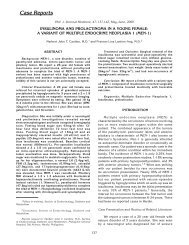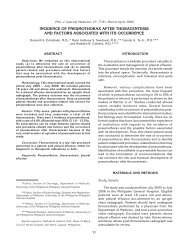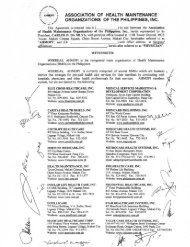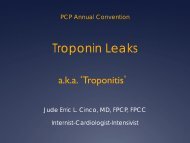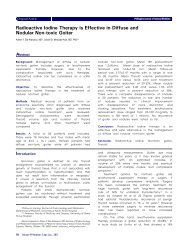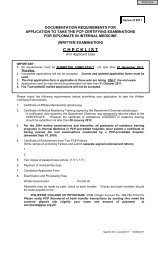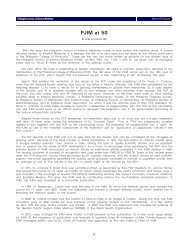d-dimer and bnp
d-dimer and bnp
d-dimer and bnp
Create successful ePaper yourself
Turn your PDF publications into a flip-book with our unique Google optimized e-Paper software.
The Coagulation Cascade
Dynamics of D-<strong>dimer</strong> FormationAdam, et.al., Blood, March 2009
Sadosty AT, et.al. Emergency department D-<strong>dimer</strong> testing.J of Emergency Medicine, Dec 2001When are D-<strong>dimer</strong> levelsraised?• pulmonary embolism• deep vein thrombosis• disseminated intravascular coagulation• Immediate postoperative state
ACCP 2012 Guidelines, Chest Feb 2012MODERATE PRETEST PROBABILITY FOR DVTHighly sensitiveD-<strong>dimer</strong>NegativePositiveNo DVTProximalUltrasoundWhole legUltrasoundNegativePositiveRepeat ProximalUS in 1 weekTreatNegativePositiveNo DVTTreat
Kinds of D-<strong>dimer</strong> assaysType of Assay Deep Vein Thrombosis Pulmonary EmbolismSensitivity(95% CI)Specificity(95% CI)Sensitivity(95% CI)Specificity(95% CI)ELISA microplate 94 (86-97) 53 (36-68) 95 (84-99) 50 (29-71)ELFA (eg. Vidas) 96 (89-98) 46 (31-61) 97 (88-99) 43 (23-65)LATEXquantitative(eg. Tinaquant)Manual wholeblood assay(eg. SimpliRed)93 (89-95) 53 (46-61) 95(88-98) 50 (36-64)83 (67-93) 71 (57–82) 87 (64-96) 69 (48-64)Righini, et.al., J ThrombHemostasis, 2008
Cost-effective AnalysisD-DIMER TESTING for ACUTE DVT/PE• A diagnostic algorithm using CLINICALPRETEST PROBABILITY FOLLOWED BY D-DIMER testing implies better use ofresources for the health care sector aswell as the society as a whole, comparedto a traditional algorithm which involvesdiagnostic imaging for all patients.Norlin, et.al., Thrombosis Research, 2010
BrainNatriureticPeptides
AtrialNatriuretic PeptideNatriureticPeptidesBrain-type Natriuretic PeptideC-type Natriuretic Peptide
Palazzuoli, et.al., VHRM 2010BNP Metabolism
Characteristic BNP NT-proBNPBiologically active Yes noProhormonefragmentC-terminalN-terminalHalf-life (min) 20 60-120In vitro samplestability (roomtemperature)Sample typeAssay measuringrange (pg/ml)4 hrs > 3 daysWhole blood,plasma (EDTA)Plasma (heparin) orserum5 – 5000 20 – 25,000** Vidas
When are BNP levels raised?• Blood levels of BNP <strong>and</strong> proBNP are raised in patientswith cardiac disease, particularly those with heartfailure• Not merely a measure of systolic function, but maybe raised in patients with elevated left ventricular(LV) filling pressure due to valve disease, diastolicdysfunction, <strong>and</strong>/or myocardial ischemia
When is BNP indicated?• may be used to help detect, diagnose, <strong>and</strong> evaluate theseverity of heart failure• may be done on patients who have symptoms suchas edema, dyspnea, <strong>and</strong> fatigue• Help differentiate between heart failure <strong>and</strong> otherproblems, such as lungdisease/corpulmonale/pulmonary embolism• may also be used to monitor the effects of treatmentfor heart failure <strong>and</strong> predict the cardiovascularprognosis in certain conditions other than heart failure,like acute coronary syndrome or cardiovascular surgery
Testing for BNP <strong>and</strong> NT-proBNP in the Diagnosis <strong>and</strong>Prognosis of Heart FailureEvidence Report/Technology Assessment No. 142. (Prepared by the McMasterUniversity Evidence-based Practice Center under Contract No. 290-02-0020). AHRQPublication No. 06-E014. Rockville, MD: Agency for Healthcare Research <strong>and</strong>Quality.Balion C, Santaguida P, Hill S, Worster A, McQueen M, Oremus M, McKelvie R,Booker L, Fagbemi J, Reichert S, Raina P. September 2006.• Diagnosis: Pooled sensitivity <strong>and</strong> specificity valueswere 94 <strong>and</strong> 66%for BNP <strong>and</strong> 92 <strong>and</strong> 65 % for NTproBNP;there was minimal difference amongsettings (emergency, specialized clinics, <strong>and</strong>primary care). B-type natriuretic peptides alsoadded independent diagnostic information abovetraditional measures for HF.
Testing for BNP <strong>and</strong> NT-proBNP in the Diagnosis<strong>and</strong> Prognosis of Heart FailureEvidence Report/Technology Assessment No. 142. (Prepared by the McMasterUniversity Evidence-based Practice Center under Contract No. 290-02-0020). AHRQPublication No. 06-E014. Rockville, MD: Agency for Healthcare Research <strong>and</strong>Quality.Balion C, Santaguida P, Hill S, Worster A, McQueen M, Oremus M, McKelvie R,Booker L, Fagbemi J, Reichert S, Raina P. September 2006.• Prognosis: Both BNP <strong>and</strong> NT-proBNP were found to beindependent predictors of mortality <strong>and</strong> other cardiaccomposite endpoints in patients:1) with risk of coronary artery disease (CAD) (risk estimaterange = 1.10 to 5.40)2) diagnosed CAD (risk estimate range = 1.50 to 3.00)3)diagnosed HF patients (risk estimate range = 2.11 to 9.35)• With respect to screening, the AUC values (range = 0.57 to0.88) suggested poor performance.
Testing for BNP <strong>and</strong> NT-proBNP in the Diagnosis<strong>and</strong> Prognosis of Heart FailureEvidence Report/Technology Assessment No. 142. (Prepared by the McMasterUniversity Evidence-based Practice Center under Contract No. 290-02-0020). AHRQPublication No. 06-E014. Rockville, MD: Agency for Healthcare Research <strong>and</strong>Quality.Balion C, Santaguida P, Hill S, Worster A, McQueen M, Oremus M, McKelvie R,Booker L, Fagbemi J, Reichert S, Raina P. September 2006.• Monitoring Treatment: Studies showed therapyreduced BNP <strong>and</strong> NT-proBNP, however, relationshipto outcome was limited <strong>and</strong> not consistent.• There is insufficient evidence to demonstrate thatBNP <strong>and</strong> NT-proBNP levels show change in responseto therapies to manage stable chronic HF patients.
CLASS I RECOMMENDATION FOR HOSPITALIZED PATIENTS• Concentrations of B-type natriuretic peptide (BNP) or N-terminal pro-B-type natriuretic peptide (NT-proBNP)should be measured in patients being evaluated fordyspnea in which the contribution of HF is not known.Final diagnosis requires interpreting these results in thecontext of all available clinical data <strong>and</strong> ought not to beconsidered a st<strong>and</strong> alone test. (Level of Evidence: A)
Class IIA RECOMMENDATION: INITIAL CLINICAL ASSESSMENT OFPATIENTS WITH HEART FAILUREMeasurement of natriuretic peptides (BNP <strong>and</strong> NT- proBNP) canbe useful in the evaluation of patients presenting in the urgentcare setting in whom the clinical diagnosis of HF is uncertain.Measurement of natriuretic peptides (BNP <strong>and</strong> NT-proBNP) canbe useful in risk stratification. (Level of Evidence: A)
Decisional algorithm for HF diagnosison the basis of BNP measurement:Palazzuoli, et.al., VHRM 2010
BNP <strong>and</strong> Outcome• Predischarge BNP measurement appears a strongpredictor for identifying subsequent death orhospital admission at 6 months• In patients with CAD <strong>and</strong> preserved ventricularfunction, BNP provides strong <strong>and</strong> incrementalprognostic information to traditional risk factors• Morbidity <strong>and</strong> mortality in CHF appear toincrease markedly with a proBNPconcentration>500 pg/mLPalazzuoli, et.al., VHRM 2010
Role of serial BNP measurement• Parallel the clinical severity of HF as assessed by NYHA class in broadpopulations.• Levels higher in hospitalized patients <strong>and</strong> tend to decrease duringaggressive therapy for HF• Cannot be assumed that BNP levels can be used effectively as targets foradjustment of therapy in individual patients. Many patients taking optimaldoses of medications continue to show markedly elevated levels of BNP,<strong>and</strong> some patients demonstrate BNP levels within the normal rangedespite advanced HF.• Use of BNP measurements to guide the titration of drug doses has notbeen shown conclusively to improve outcomes more effectively thanachievement of the target doses of drugs shown in clinical trials to prolonglife.Jessup, et.al., 2009 focused update of ACC/AHA Guidelines on Management of Heart Failure. JACC 2009
Factors that may affect BNP levelsIncreased levels:• Increasing age• Females• African-American <strong>and</strong>Hispanics• kidney disease• Atrial fibrillationDecreased levels• therapies for heartfailure such as ACEinhibitors, betablockers, <strong>and</strong> diuretics• obesity* While both BNP <strong>and</strong> NT-proBNP will rise with left ventricle dysfunction<strong>and</strong> either can be measured, they are not interchangeable <strong>and</strong> the resultscannot be directly compared.Palazzuoli, et.al., VHRM 2010
Cost-effectiveness AnalyssBNP TESTING for the management of ACUTE dyspnea 2• Analysis of incremental 180-day cost-effectivenessshowed that BNP guidance resulted in lower mortality<strong>and</strong> lower cost in 80.6%• Results were robust to changes in most variables• Testing of BNP is cost-effective in patients with acutedyspnea.Mueller, et.al, Archives of Internal Med, 2006
Summary: D-<strong>dimer</strong>• generated as a result of fibrin formation <strong>and</strong>fibrinolysis• formed during processes like hemostasis, thrombosis,<strong>and</strong> tissue repair• serves as a clinically useful marker for exclusion of VTE,<strong>and</strong> evaluation of the risk of VTE recurrence in selectpopulations, when combined with clinical probability<strong>and</strong> other imaging techniques• Clinicians need to be aware of the conditions <strong>and</strong>factors that affect D-<strong>dimer</strong> levels <strong>and</strong> the differentperformance characteristics of the available assays, tomake safe <strong>and</strong> timely therapeutic decisions
Summary: BNP• Synthesized <strong>and</strong> released mainly by ventricularmyocardial cells in response to myocyte stretch,i.e. pressure or volume overload, heart failure• Affected by several factors <strong>and</strong> conditions• BNP <strong>and</strong> NT pro-BNP have different cut-off levels• Highly recommended to rule out heart failure inpatients who present with acute dyspnea• Not advised to test in asymptomatic patients
THANK YOU FOR YOURATTENTION!



